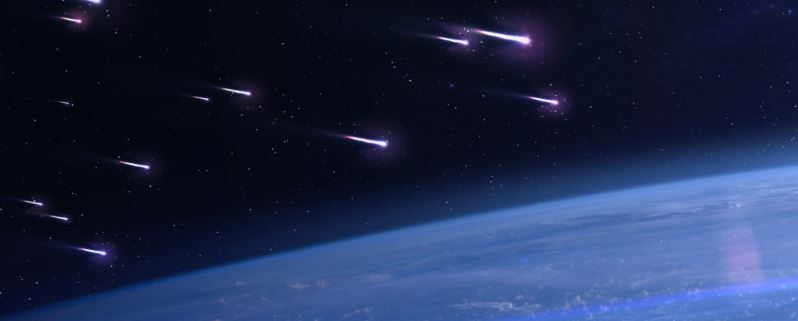


 11:18:27
11:18:27  2024-11-14
2024-11-14  1035
1035

There are good reasons to keep an eye on the Leonid meteors this year.
It's still one of the coolest things I ever saw. I was in the US Air Force in the 90s, and November 1998 saw me deployed to the dark skies of Kuwait. That trip provided an unexpected treat, as the Leonid meteors hit dramatic storm levels on the morning of the 17th.
Meteor came fast and furious towards local sunrise, often lighting up the desert floor like celestial photoflashes in the sky.
Once every 33 years or so, the 'lion roars,' as Leonid meteors seem to rain down from the Sickle asterism of the constellation Leo. And while the last outbreak was centered around the years surrounding 1999, there's some interesting discussion about possible encounters with past Leonid streams in 2024.
The Leonids in 2024
To be sure, 2024 is otherwise slated to be an off year for the shower. The normal annual maximum for 2024 is expected to occur on Sunday, November 17th at around ~4:00 Universal Time (UT), with an expected Zenithal Hourly Rate (ZHR) of 15-20 meteors per hour seen under ideal conditions. This favors Europe in the early dawn hours.
But there are also a few other streams that may arrive earlier this week and are worth watching for. Jérémie Vaubaillon of the Paris Observatory IMCCE notes that Earth may encounter three older streams from periodic comet 55p/Tempel-Tuttle.
The comet is the source of the Leonids. On a 33.8 year orbit, a meteor shower occurs when the Earth plows headlong into the stream of dust and debris laid down by the comet.
A trail laid down in 1633 (the source of the 2001 meteor storm). Earth is near this trail on November 14th at 16:37 UT, favoring northwestern North America in the early morning hours.
A dust trail from 1733, peaking on November 19/20th at 23:53 to 00:54 UT, favoring north/central Asia.
And finally, an encounter with a string of older (more than a millennium old) streams on November 14th at 16:37 UT, (the same time as the 1633 stream). It is worth noting that the 1733 stream was the suspected source of the 1866 Leonid meteor storm.
Watching this Thursday morning on the 14th could be a harbinger as to whether or not we're in for a show. Unfortunately, the moon is waxing gibbous and headed towards full this week on November 15th, meaning that it with provide increasing illumination and cut down observed meteor rates.
The Leonids on past recent years have held steady at predicted rates of about or so 20 per hour. It's worth noting that another encounter with the 1699 stream and possible outburst is predicted for next year, 2025.
Meteor shower… or storm?
Meteor storms occur when the zenithal hourly rate tops 500 or more per hour. Keep in mind, a ZHR of a thousand or higher means that you're seeing a meteor every few seconds.
The October Draconids and the December Andromedids are also prone to great outbursts, but the Leonids are the most notorious and well-known. The 1966 shower seen over the US southwest topped an amazing ZHR of up to 150,000 per hour (!)
Observing and imaging the Leonids
Early morning hours are best to see meteors, as you're standing on the swath of the surface of the Earth that's turned forward in to the stream. Pinpoint meteors will occur near the shower radiant, while long streaks will stand out out in stark profile about 45 to 90 degrees away on either side of the radiant.
I like to aim my tripod-mounted DSLR at these regions, set the lens to the widest field of view possible, and simply let it run taking auto-exposures and see what turns up. An intervalometer is a great device to automate this process. This allows me to just sit back with a steaming hot cup of tea (a must for cold November mornings) and simply watch the show, as meteors slide by.
Perhaps, we'll simply have to wait for 2030s to see strong activity from the Leonids again.
But do you really want to risk missing a surprise show? To quote hockey player Wayne Gretzky: "You miss 100% of the shots you don't take." The same holds true for missing versus catching meteor storms: you just have to show up and watch.
Reality Of Islam |
|

Researchers

A new chip-

A large inf

Choosing th
 9:3:43
9:3:43
 2018-11-05
2018-11-05
10 benefits of Marriage in Islam
 7:5:22
7:5:22
 2019-04-08
2019-04-08
benefits of reciting surat yunus, hud &
 9:45:7
9:45:7
 2018-12-24
2018-12-24
advantages & disadvantages of divorce
 11:35:12
11:35:12
 2018-06-10
2018-06-10
 6:0:51
6:0:51
 2018-10-16
2018-10-16
 7:45:39
7:45:39
 2018-06-21
2018-06-21
 3:42:22
3:42:22
 2021-12-24
2021-12-24
 8:21:9
8:21:9
 2018-06-21
2018-06-21
 12:47:1
12:47:1
 2022-12-20
2022-12-20
bahlool & the throne of haroun rashid
 8:20:35
8:20:35
 2018-06-21
2018-06-21
 9:30:2
9:30:2
 2021-11-12
2021-11-12
 8:19:41
8:19:41
 2018-06-21
2018-06-21
 5:41:46
5:41:46
 2023-03-18
2023-03-18
| LATEST |